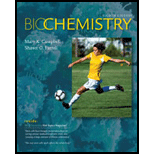
Biochemistry
8th Edition
ISBN: 9781285429106
Author: Campbell, Mary K., FARRELL, Shawn O.
Publisher: Cengage Learning,
expand_more
expand_more
format_list_bulleted
Concept explainers
Textbook Question
Chapter 13, Problem 3RE
REFLECT AND APPLY When proteins are separated using native gel electrophoresis, size, shape, and charge control their rate of migration on the gel. Why does DNA separate based on size, and why do we not worry much about shape or charge?
Expert Solution & Answer
Trending nowThis is a popular solution!

Students have asked these similar questions
The rate data from an enzyme catalyzed reaction with and without an inhibitor present is found in the image.
Question: what is the KM and Vm and the nature of inhibition
1. Estimate the concentration of an enzyme within a living cell. Assume that:
(a): fresh tissue is 80% water and all of it is intracellular
(b): the total soluble protein represents 15% of the weight
(c): all the soluble proteins are enzymes
(d): the average molecular weight of the proteins is 150,000
(E): about 100 different enzymes are present
please help I am lost
Please help
Chapter 13 Solutions
Biochemistry
Ch. 13 - RECALL What advantages does fluorescent labeling...Ch. 13 - RECALL What methods are used to visualize...Ch. 13 - REFLECT AND APPLY When proteins are separated...Ch. 13 - RECALL How does the use of restriction...Ch. 13 - RECALL What is the importance of methylation in...Ch. 13 - RECALL Why do restriction endonucleases not...Ch. 13 - Prob. 7RECh. 13 - Prob. 8RECh. 13 - RECALL What do the following have in common? MOM;...Ch. 13 - RECALL Give three examples of DNA palindromes.
Ch. 13 - RECALL What are three differences between the...Ch. 13 - RECALL What are sticky ends? What is their...Ch. 13 - RECALL What would be an advantage of using HaeIII...Ch. 13 - RECALL Describe the cloning of DNA.Ch. 13 - RECALL What vectors can be used for cloning?Ch. 13 - RECALL Describe the method you would use to test...Ch. 13 - RECALL What is blue/white screening? What is the...Ch. 13 - Prob. 18RECh. 13 - Prob. 19RECh. 13 - Prob. 20RECh. 13 - Prob. 21RECh. 13 - Prob. 22RECh. 13 - Prob. 23RECh. 13 - REFLECT AND APPLY What are the requirements for an...Ch. 13 - Prob. 25RECh. 13 - Prob. 26RECh. 13 - REFLECT AND APPLY The genes for both the a- and...Ch. 13 - REFLECT AND APPLY Outline the methods you would...Ch. 13 - Prob. 29RECh. 13 - Prob. 30RECh. 13 - Prob. 31RECh. 13 - Prob. 32RECh. 13 - RECALL Why is temperature control so important in...Ch. 13 - RECALL Why is the use of temperature-stable DNA...Ch. 13 - RECALL What are the criteria for good primers in a...Ch. 13 - REFLECT AND APPLY What difficulties arise in the...Ch. 13 - REFLECT AND APPLY Each of the following pairs of...Ch. 13 - RECALL What is qPCR?Ch. 13 - Prob. 39RECh. 13 - REFLECT AND APPLY Suppose that you are a...Ch. 13 - REFLECT AND APPLY Why is DNA evidence more useful...Ch. 13 - REFLECT AND APPLY Give the DNA sequence for the...Ch. 13 - Prob. 43RECh. 13 - Prob. 44RECh. 13 - Prob. 45RECh. 13 - Prob. 46RECh. 13 - Prob. 47RECh. 13 - RECALL Has proteomic analysis been done on...Ch. 13 - Prob. 49RECh. 13 - Prob. 50RECh. 13 - Prob. 51RECh. 13 - RECALL What are the key differences between DNA...
Knowledge Booster
Learn more about
Need a deep-dive on the concept behind this application? Look no further. Learn more about this topic, biochemistry and related others by exploring similar questions and additional content below.Similar questions
- The following data were recorded for the enzyme catalyzed conversion of S -> P. Question: Estimate the Vmax and Km. What would be the rate at 2.5 and 5.0 x 10-5 M [S] ?arrow_forwardPlease helparrow_forwardThe following data were recorded for the enzyme catalyzed conversion of S -> P Question: what would the rate be at 5.0 x 10-5 M [S] and the enzyme concentration was doubled? Also, the rate given in the table is from product accumulation after 10 minuets of reaction time. Verify these rates represent a true initial rate (less than 5% turnover). Please helparrow_forward
- The following data was obtained on isocitrate lyase from an algal species. Identify the reaction catalyzed by this enzyme, deduce the KM and Vmax , and determine the nature of the inhibition by oxaloacetate. Please helparrow_forwardIn the table below, there are sketches of four crystals made of positively-charged cations and negatively-charged anions. Rank these crystals in decreasing order of stability (or equivalently increasing order of energy). That is, select "1" below the most stable (lowest energy) crystal. Select "2" below the next most stable (next lowest energy) crystal, and so forth. A B 鹽 (Choose one) +2 C +2 +2 (Choose one) D 鹽雞 (Choose one) (Choose one)arrow_forward1. Draw the structures for the fats A. 16:2: w-3 and B. 18:3:49,12,15 2. Name each of the molecules below (image attached)arrow_forward
- draw the structures for the fats A. 16:2:w-3 B 18:3:9,12,15arrow_forward1. Below is a template strand of DNA. Show the mRNA and protein that would result. label the ends of the molecules ( refer to attached image)arrow_forwardAttach the followina labels to the diagram below: helicase, single stranded binding proteins, lagging strand, leading strand, DNA polymerase, primase, 5' ends (3), 3' ends (3) (image attached)arrow_forward
- 1. How much energy in terms of ATP can be obtained from tristearin (stearate is 18:0) Show steps pleasearrow_forwardMultiple choice urgent!!arrow_forward1. Write the transamination reaction for alanine. Indicate what happens next to each of the molecules in the reaction, and under what conditions it happens. 2.arrow_forward
arrow_back_ios
SEE MORE QUESTIONS
arrow_forward_ios
Recommended textbooks for you
 BiochemistryBiochemistryISBN:9781305961135Author:Mary K. Campbell, Shawn O. Farrell, Owen M. McDougalPublisher:Cengage Learning
BiochemistryBiochemistryISBN:9781305961135Author:Mary K. Campbell, Shawn O. Farrell, Owen M. McDougalPublisher:Cengage Learning

Biochemistry
Biochemistry
ISBN:9781305961135
Author:Mary K. Campbell, Shawn O. Farrell, Owen M. McDougal
Publisher:Cengage Learning
Biomolecules - Protein - Amino acids; Author: Tutorials Point (India) Ltd.;https://www.youtube.com/watch?v=ySNVPDHJ0ek;License: Standard YouTube License, CC-BY